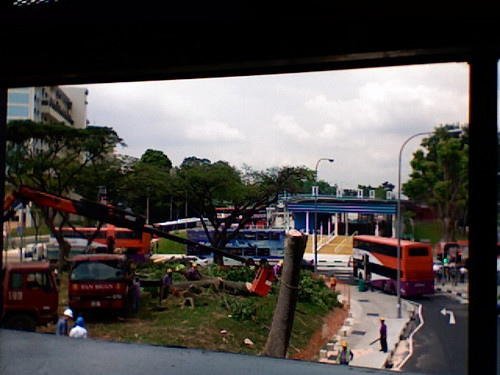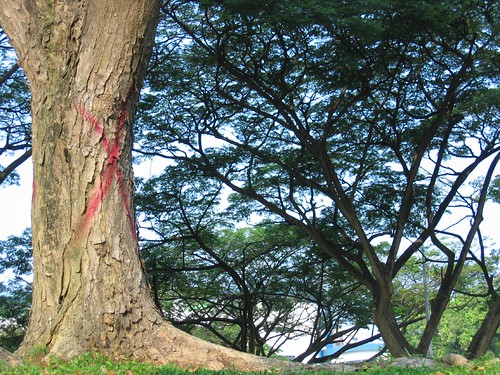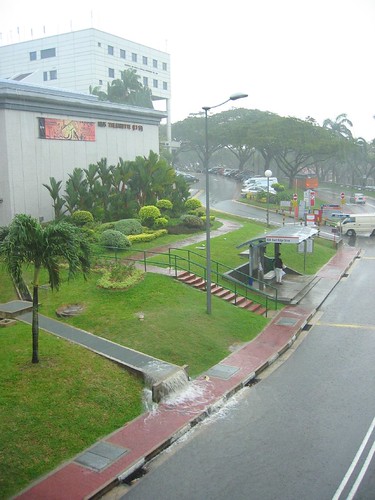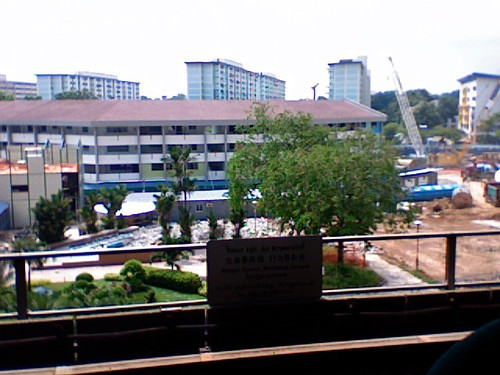2 days ago on 22 Novmber 2006, I unwittingly witnessed the cutting of the trees that was pictured on this blog earlier this month.
Although it was unevitable as they were marked with the cross of death already, and I did see it coming, but it doesn't hit home until you witness it for yourself.
I was not the only one who stood there watching. In fact I was surprised but almost pleasantly pleased that a row of people had gathered along the bridge leading to the MRT station, standing, watching the execution of these old trees. They have afterall been part of the landscape for the last 30 years. Young and old gathered to watch. I hadn't bring my camera so I whipped out my laptop, placing it on top of a gathering layer of wood dust and took the photo. It feels almost as if I was placing my laptop upon the blood of the tree.
Really this is not about sentimentality.
The divinebovine and I had this conversation where [for arguments sake] she said that my agony at the cutting of these non-native, wayside trees are just part of this senseless sentimentality that had no conservational value whatsoever.
I am sure many people would feel the same way but let me tell you why I, if not everybody, was gathered there watching, if not because they were enjoying the show.
1) These trees were part of the community. The falling of the trees is only the first sign of much more change that is to come.
2) The trees provided great amount of shade. Previously the shade provided by the cover of just 10 of these expansive raintrees were able to provide shade for the entire bus interchange area. Honestly, now when you go to Clementi, if you found it extremely bright, that is because the trees are gone. Previously they softened the harsh reflectance of the light by absorbing it but now the light is directly reflecting on the concrete which has a higher albedo (it's white so it reflects and does not absorb any). Thus the entire area becomes extremely bright and almost harshly so. It would also seem a lot hotter because there are no layer of tree canopies to filter off most of the brunt of the heat for you.
3) I understand that for a development project like that it seems almost impossible to go save a few trees. It's easier to just remove everything. But this cut and plant another attitude is hardly to be desired. It does not take into account the time taken for the plants to grow before it can provide equivalent services to the neighborhood. How much shade or even aesthetic decoration can a small sapling provide as compared to a mature tree? The old tree was not sick and if it was, cutting it down would be understandable.
4) A whole generation would not enjoy any shade at all, cept that provided by man-made shelters which surely cost more money to build than to cut down or even just to maintain an already grown tree. My children would never enjoy the wholesome greens of Clementi and their children might get to see it provided if the landscape designer of today would choose the right types of greens to replace the old rain trees. But what if we got some shadeless palms or some horticultural varieties that would never grow beyond a height of 5m or provide any shade at all? What then?
5) As my dad pointed out the other day, why are the architects, planners and landscape designer turning out grass-covered, tree lined estates into literal concrete jungles? Fields are turned into conrete gathering point because possibly some people complained that they did not enjoy tripping over the grass. But falling on grass is definitely better than scraping your knees on cement floors. In his words, my dad said "Singapore is trying to be a green garden city so what happened to all our trees?" More and more estates are losing their shady pathways and green fields and being replaced with covered walkways, horticultural garden bushes which sometimes do not last at all. So a line of bouganvillas welcoming you to Singapore along the PIE to the airport makes us a Garden City but what about our own estates? This is not acceptable. We HAD a green garden city. Why change it? Why make it lesser than what it was before?
6) Concretizing most of our ground cover leads to increased floods. Grass covers help to allow the rainfall to seep through into the ground. People may complain about grubby grass fields but then it does help increase the water being absorbed into the ground before coming out in our drains. It slows down the time taken for all the water to start gushing to the drains. But if everything is concrete, no matter how good our engineers are, you cannot deny the fact that when rain cannot go through the ground, it straightaway goes for the drain without first being slowed down which the soil did for it before. The soil was like a pillow, absorbing the intensity.  With so much water gushing for the drain all at the same time, I wonder if the small little drains would be able to deal with the volume. But of course, these days, we have large sewers and storm drains, and engineering feats triumph once again. However no matter how big your drains are, the engineers were basing that on the projection of a particular amount. If one day you get an amount that is higher than expected, then what? Essentially, according to the planning class I took, grass covers are always better than concrete covers. This applies for carparks and walkways. You know those annoying ground cover where its like concrete but with holes where grass grow in between? I use to hate those because I always fall into the holes but those are the kind of structures that help water to permeate the ground. Of course nowadays we mostly have multistory carparks so who cares right? Besides many of my architect friends are all into green designs these days. So how come I seldom see such things put into practice around me?
With so much water gushing for the drain all at the same time, I wonder if the small little drains would be able to deal with the volume. But of course, these days, we have large sewers and storm drains, and engineering feats triumph once again. However no matter how big your drains are, the engineers were basing that on the projection of a particular amount. If one day you get an amount that is higher than expected, then what? Essentially, according to the planning class I took, grass covers are always better than concrete covers. This applies for carparks and walkways. You know those annoying ground cover where its like concrete but with holes where grass grow in between? I use to hate those because I always fall into the holes but those are the kind of structures that help water to permeate the ground. Of course nowadays we mostly have multistory carparks so who cares right? Besides many of my architect friends are all into green designs these days. So how come I seldom see such things put into practice around me?

As I watched on further from the MRT station platform, I thought with some irony that the sign "Value life, Act Responsibly" in front of the destruction at the back was quite apt.
Are we valueing the life we are removing today? Do we replace them suitably and sufficiently later? Are we acting responsibly for our future generations or even this current generation who have to suffer the heat of development, literally. It is only us who have seen what we had before that would appreciate what we have lost. Would my children ever appreciate what was lost if they would never have the joy of enjoying the shade?
Of course, next time they would be enjoying the shade of concrete buildings, air conditioned walkways and covered rainshelters. Just look at Toa Payoh Hub. Do you see any spot of green? Everybody enjoys the airconditioning, the shelters, the conrete concourse with perhaps a few palms or bushes (no deep impressions there). Who would need trees? Or think of them even! If only we step far away from that area then we see the old trees that gives the estate character. Ok, so they are not native and they are not extremely big or tall or rare. But what about the simple services these trees give?
At the end of the day, do you want a green city with lucious foilage relaxing your minds and eyes or a garden city with airconditioned structures and little manicured horticultural bushes in straight lines? How different is the latter from any urban city in this world? And I always thought it was the trees that set us apart.
Friday, November 24, 2006
Goodbye Clementi part Deux
Posted by
Monkey
at
Friday, November 24, 2006
![]()

 I can be contacted at
I can be contacted at 







No comments:
Post a Comment